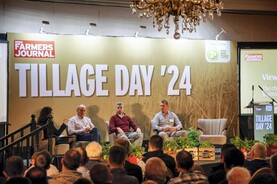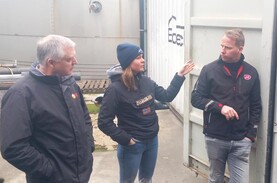Potato farmers are a different breed. Having endured a nightmarish 2023 and a very difficult and late planting season, Wexford potato growers gathered in Enniscorthy on Thursday evening for a meeting.
Local grower Sean Ryan is the Irish Farmers Association (IFA) national chair and he was joined by Robert Malone and Niamh Brennan, the executive staff members who share responsibility for the potato and horticulture sections within the IFA.
I tagged along for my first ever potato meeting.
The first thing that would strike the casual attendant was how few people were at the meeting, compared with a livestock, dairy or indeed tillage meeting. But potato growing is a specialised business and not for the faint-hearted.
Most potato growers also grow vegetables of one form or another. All of them grow a large amount of grain - rotation demands mean they can only plant potatoes one year in four.
Most growers rent and swap land with specialised grain growers, but almost all would have quite extensive acreages of corn.
Specialised sector
While 50 years ago every farmer - and quite a large proportion of rural dwellers in general - grew their own potatoes, it has become a very specialised sector nowadays.
There are only 600 commercial potato growers in Ireland, so each one is essentially growing spuds for over 8,000 people - for the whole year.
Of course, the other big change over the last 50 years is that potatoes, while still a staple of the national diet, are no longer consumed 365 days a year.
An uncle of mine was having dinner with us one day and our youngest exclaimed “potatoes again!”. My uncle asked: “What do you mean ‘again’? You have potatoes every day.”
“We surely don’t,” came the reply. “We have rice and pasta and cous-cous different days.”
Potatoes have to fight their corner with other starchy foods these days, even in Ireland, the home of the spud.
Teagasc says that annual potato consumption has decreased from 140kg per person to 85kg in just 30 years. The current consumption rate, while strikingly lower, is still 250% that of the global average.
So the typical area planted to potatoes nationally hovers between 7,000ha and 8,000ha annually. Compare that with the 332,000ha in 1850 and you see how much production has contracted.
Busy agenda
The group may have been relatively small in Enniscorthy on Thursday, but there was a lot of business to be attended to. There were market updates, both from the top table and the floor.
Weather played havoc with early planting, with the result that instead of the very first new potatoes of the year coming from Carne, on the tip of south Wexford, a significant amount were imported.
Planting caught up in May, with the final hectarage well up on last year. And quality of the Irish early potatoes, when they came to market, has been excellent.
Of course, planting potatoes is only half the battle. They have to be nurtured and protected during the growing season and then extracted from the ground so smoothly they can happily be stored for months.
Last year’s harvest was a battle from start to finish, with news clips of sodden fields, with huge losses from rotten tubers and machines bogging trying to salvage them.
The worst years are when there are too many potatoes and it becomes a buyers’ market
The good thing about the potato market is that when yields are down, price is better, so they can balance each other out to a degree. In fact, the worst years are when there are too many potatoes and it becomes a buyers’ market.
Most growers have an anchor customer, whether they deal directly with a retailer or with a pack house. Either way, there are only a handful of retailers and packhouses, so growers don’t have much market power.
It must frustrate them that they have no right to collective bargaining. Robert Malone explained that when the IFA would meet retailers in the next couple of weeks in advance of the start of the maincrop harvest, they could talk about volumes, discuss imports and the need to prioritise Bord Bia quality assured Irish potatoes.
They could raise the issue of product promotions, talk of marketing of potatoes. They could discuss ways of cutting the level of food waste. The one thing they couldn’t do - the thing that they are legally prevented from doing - is to even mention price.
Consumer and competition law is the reason for this prohibition. It’s seen to benefit consumers by removing the possibility of price collusion by suppliers or between suppliers and retailers. I wonder who will defend this perspective if it ends up helping the death of food production on this tiny island.
Because without a decent price on an ongoing basis, potato and vegetable growing will continue to decline.
Having almost no growers won’t benefit competition and it won’t benefit consumers, but it seems to me that a free-market orthodoxy stifles lateral thought in this crucial area.
Downward spiral needs reversing
The other thing that was apparent from the meeting was the palpable frustration among growers at the declining number of tools they have at their disposal to protect their crop.
Potato farmers have to spend more time in their sprayers than most food producers, because potato blight is a constant threat. As one farmer put it “we don’t want to be in sprayer cabs or tractor cabs, but we learned we can’t grow potatoes organically in 1847”.
Of course, individuals can grow potatoes organically, but it isn’t really feasible on a mass commercial scale. In fact, one grower reported that the Dutch government has this year banned the growing of potatoes organically (presumably above a certain scale) for fear of more widespread contamination emanating from unprotected crops.
Potatoes have to be sprayed to prevent blight every ten days in a normal year; but this year it’s just about once a week. There are fears the EU’s commitment to reducing overall pesticide usage by 50% will impact on the availability and frequency of use permitted of essential chemistry.
It’s a triple-threat facing potato production across the EU
The problems all crops are facing are particularly troubling for potato growers. Diquat, a widely-used dessicant, is only available on special emergency dispensation, with the case having to be made for its necessity annually.
Growers were saying on Thursday that with planting later than normal, other ways of dessicating crops will prove more difficult.
The problem is much deeper than Diquat, though. It’s a triple-threat facing potato production across the EU.
The loss of chemistry is exacerbated by the paucity of research to develop new protection products for the European market.
Licensing is more heavily regulated than in other parts of the world, so it’s easier to develop a product and market practically anywhere else on the planet.
And multinational companies are fond of the path of least resistance when investing in research and development - understandably so.
The final linked issue is the EU’s continuing reluctance to grab the potato stalk when it comes to utilising available technology to help a plant cope with threats and maximise production in the climate it finds itself in.
Genetic modification has come a long way since the cruder Roundup-ready plants of 20 years ago.
It’s now an ideal tool to tackle the conundrum of producing as much or more food from a shrinking land base with less artificial nutrients and less chemical protection in a changed and challenging climate.
But Europe, so keen to follow the science when it comes to farm pollution issues, is putting politics above the balance of evidence before us, particularly when it comes to CRISPR and other forms of gene editing. Potato growers are as frustrated as anyone by this impasse.
More acres this year
The meeting heard that overall acres planted are up this year, but that is compared to low planting in 2023.
One newish market that is expanding is for salad potatoes, which of course have a much lower yield in terms of tonnes/ha.
The feeling in the room was that headlands and wet spots in fields would mean the map acres planted overstates the area which will yield potatoes as we move into the maincrop this month.
The big issue is the lack of seed potatoes. Ever since Brexit, we have heard about the threat to the commercial potato sector from the loss of the Scottish seed potatoes.
Eight years on, that is still a live issue, but we haven’t significantly increased the acreage of seed potatoes. Only 250ha of seed has been planted, down 14ha on last year.
Some growers reported that seed potatoes from the continent were of very mixed quality.
To an outsider like me, it seemed blindingly obvious that we urgently need to expand domestic seed potato growing as a national priority.
It’s an extremely specialised and risky enterprise, so the State should perhaps get more involved. Ireland without potatoes would be like Skibbereen without Olympic rowers.
Final yarn
One final yarn. A friend of mine was entertaining some American guests and had to endure some gentle ribbing about the national obsession with the humble spud.
He refused to accept this stereotype and explained that the Irish diet was now a palate of world cuisine.
Soon after, the Americans wondered if Ireland had any decent theme parks, which form such a key part of many holidays to the United States.
My friend, of course, thought of Tayto Park (now called Emerald Park), then thought of the slagging that would ensue and said “no”.
Have a great bank holiday weekend and have a few spuds along the way.






 This is a subscriber-only article
This is a subscriber-only article










SHARING OPTIONS: